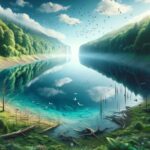
Early October Geoscience Link Roundup
This month’s roundup of geoscience links is arriving ahead of schedule to highlight the flurry of activity and insights expected from the SEG Annual Meeting. For those keen on absorbing every detail from this event, subscribing to email updates is the best way to ensure no highlights are missed.
In the realm of mathematical concepts explored within the Linkfest theme, one particularly intriguing subject is the application of the harmonic mean equation, offering a fascinating glimpse into the interconnectedness of numerical relationships and their broader implications.
Discoveries in Open Geoscience
Recent days have brought attention to several notable developments in the open geoscience sphere:
- Dave Hale has unveiled an innovative fault detection code that’s catching eyes;
- Wayne Mogg has introduced new OpendTect plugins aimed at enhancing AVO, filtering, and time-frequency analysis;
- A team led by Joel Gehman at the University of Alberta and McGill University has launched WellWiki, a comprehensive wiki dedicated to wells;
- Jon Claerbout of Stanford, alongside Sergey Formel of Austin, has published their latest work, “Geophysical Image Estimation by Example.” This masterpiece not only impresses with its insights but also offers the associated code for public use, serving as an invaluable tool;
- Additionally, a noteworthy mention goes to “Petroacoustics: A Tool for Applied Seismics” by Patrick Rasolofosaon and Bernard Zinszner. While this resource is available at no cost, its strict usage terms limit its application. Acknowledgment goes to Chris Liner for spotlighting this work.
Unveiling Geoscience Insights Through Open Data

In the realm of earthquake detection, open data sharing presents immense possibilities, leveraging the ubiquity of smartphones over traditional seismometers. The dynamic nature of the USGS shake map, continually evolving in real-time, underscores this potential. Remarkably, companies like Jawbone, creators of the UP activity tracker, utilize proprietary data to detect sleep disturbances, marking a pioneering step in passive human-digital sensing.
At the nexus of web innovation and computational prowess lies Wolfram Alpha’s latest marvel: a “Tweet a program” bot. Demonstrating its prowess, a simple query generates intricate visualizations, such as mapping geological entities like the Atlantic Ocean’s volcanoes, showcasing the convergence of technology and geoscience.
The fusion of technology and geoscience reveals astonishing capabilities, including the ability to extract sound from silent video imagery. Historical events like the Krakatoa eruption of 1883 exemplify this synergy, where the pressure waves recorded by barometers offer insights into seismic activity, illustrating the unanticipated sources of data.
As volcanic eruptions captivate global attention, the acoustic dimension adds a new layer of understanding. Observing shockwaves and the resultant atmospheric phenomena unveils the complexity of nonlinear waves, challenging conventional assumptions about wave behavior and the speed of sound.
Fostering Dialogue and Cooperation

Our community is making strides towards fostering a culture of inquiry and collaboration, albeit not as seamlessly as seen in the programming realm. Recent discussions sparked by posts on data management issues have been both lively and constructive, with active participation on both the blog and LinkedIn platforms. Notably, a spirited debate ensued regarding the complexities surrounding the Lusi post, shedding light on the nuanced nature of the topic. This incident marked a significant milestone as it initiated the first online discourse concerning a sonic log.
Conclusion
LinkFest, with its early arrival this year, has sparked significant activity and growth within the geoscience community. With the contributions of various individuals and institutions, it promises to foster an ever more connected and informed geoscience community. As it continues to evolve and incorporate more features, we look forward to the future prospects of this unique platform.

















